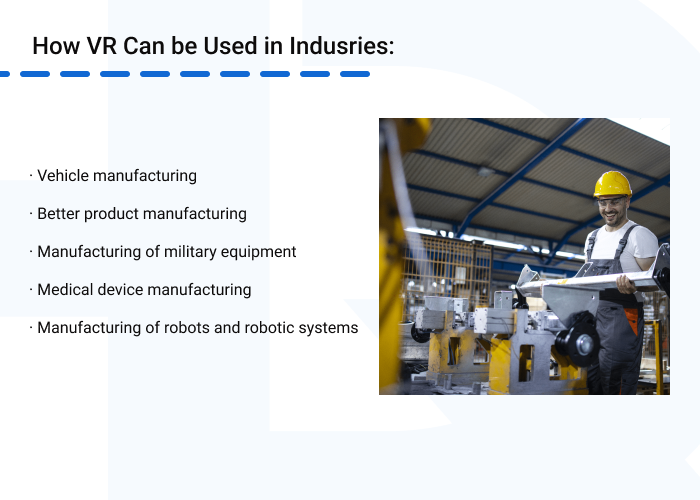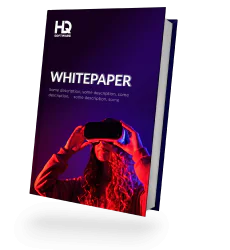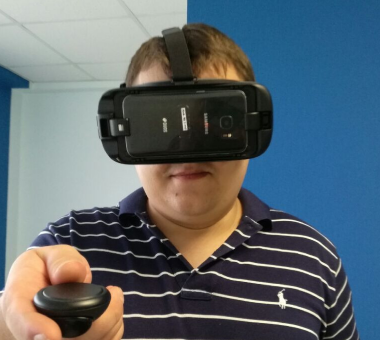How VR Can be Used in Manufacturing
How VR Can be Used in Industries
Benefits of Virtual Reality in Manufacturing
The Technology Stack for VR in Manufacturing
The potential for Virtual Reality to support and enhance every industry is significant, and manufacturing is no exception. With the ability to provide a realistic immersive environment for workers to interact with virtual 3D models of tools and manufacturing equipment, VR is becoming an increasingly popular tool for factories, production industry and other industrial facilities. In this article, we will discover the main possibilities for applying VR in manufacturing industry and explore its benefits from the perspective of AR/VR developer.
How VR Can be Used in Manufacturing
How VR Can be Used in Industries
Benefits of Virtual Reality in Manufacturing
The Technology Stack for VR in Manufacturing
VR for manufacturing is a form of interactive simulation that allows manufacturers to create an immersive experience for testing and production of a 3D structure of any model. VR allows manufacturers to create virtual models and simulations of their products. They can be used to test different features and scenarios and find the best way to produce them. Using VR technology, manufacturers can easily show the whole product or its tiny components to demonstrate its functionality. This technology can be used to create prototypes of machines, tools, manufacturing equipment, or systems; to test products; and train employees.
VR offers significant potential to support and enhance manufacturing processes. The global Virtual Reality market in the manufacturing industry is forecasted to grow from $924.7 million in 2018 to $14,887.0 million by 2026, at a CAGR of 39.2% during that period. Aspects such as the growing adoption of VR in process optimization, 3D prototyping, and quality maintenance are driving the rapid growth of VR technology in the manufacturing industry globally.
Due to its ability to recreate complex technological processes and visualize their operation, VR is widely used in manufacturing, within various use cases. Applying Virtual Reality in manufacturing provides a flexible and immersive environment for better product design and employee training.
In the field of manufacturing VR can be used to create virtual prototypes of products, tools, equipment, and production lines, recreating a variety of technological processes. Prototypes can be tested and refined before they are fully produced. VR prototyping is a computer-generated simulation of a 3D environment that can be interacted with using special VR headsets.
Using VR, manufacturers can create immersive simulations of their products and workflows to test new designs and processes before committing to expensive physical prototypes. Such interactive models allow engineers to see the product in the virtual environment and make all necessary adjustments before it is fully developed. This helps identify any potential issues in the early stages of production and allows for changes as needed.
VR prototyping allows companies to improve the quality of their products while reducing product development costs and time. It enables manufacturers to attract investments, boost innovation, and increase speed-to-market for their products.
Interested in VR for manufacturing? Feel free to contact us!HQSoftware has a team of experienced VR experts to implement your project.
Anna Halias
Business Development Manager,
HQSoftware
Using a virtual environment, manufacturers can see the infrastructure of their future enterprise under construction and walk around an object modeled in 3D format. By loading a 3D model of a building or premises designed in VR, designers can see the project on a 1:1 scale. This helps to better assess the quality of the design as well as the ergonomic characteristics of the object, which cannot be done by just looking at a 3D model on a monitor screen. A 1:1 scale prototype lowers the cost and time required to prepare a mock-up commission.
Within the virtual environment, specialists from the logistics, security, and inventory management departments can coordinate the location of equipment on the premises and the organization of manufacturing facilities. They can test scenarios for the plant’s future work and safety compliance before the building is put into operation.
VR training makes it possible to train employees to operate new equipment or carry out safety procedures without the need for costly and time-consuming real-world training. Efficiency is attained by both the ability to master multiple tools and the capacity of VR to immerse users in real-world scenarios. In a safe VR environment, specialists can practice how to serve and maintain an enterprise, studying a proven algorithm of actions in different situations. This may involve synchronizing operations by several employees or rarely repeated but critical procedures.
VR minimizes the risks related to an accident in production or the breakdown of expensive equipment. Trainees do not just formally memorize the procedure; they visually work it out at each stage of work. Virtual learning in manufacturing can be digitally scaled to a large number of employees, and it allows for unlimited practice before automating actions. It is possible to train remotely with minimal assistance from professional mentors. Because of its ability to effectively load balance, VR training programs in manufacturing reduces the cost of hiring specialists who teach staff.
With VR, you can simulate emergencies for training purposes. Often, it is either dangerous or impossible to reproduce emergency situations in real life. So, employees have only theoretical knowledge of how to respond to difficult situations. Leveraging VR for safety training can prepare them for any challenge. Executing an evacuation plan and safety testing in an interactive environment allows employees to acquire better skills more quickly.
VR safety training eliminates the risk of financial damage to the company and harm to the trainee while learning. Safety directors can train new employees more effectively by using virtual content, such as employee instructions to assess their performance. They are able to track data and report analytics on the effectiveness of the training, or use this information to create standards and guidelines for manufacturing workplace safety. As a result, this can lower the possibility of penalties or claims.
Virtual Reality in the manufacturing industry is used for simulating manufacturing processes, testing, and research purposes. It can be used to design new processes, create 3D models, and develop a VR demonstrator for production line automation.
VR lets employees understand the value of production by allowing them to adapt processes rapidly in real-time without compromising on quality or safety standards.
As well, VR helps factories become more productive by automating processes and planning production activities. The virtual environment allows businesses to optimize their floor space, moving workers and shifting equipment as needed. It is also possible to test factory settings in VR. The speed and quality of production play an important role in the success of the enterprise, so it is possible to save time on processes that can run in parallel to each other.
Industrial and equipment inspections are two examples of using VR in manufacturing. Safety inspectors and plant management can simultaneously monitor every aspect of the production and make any necessary improvements quickly and easily.
VR is an effective tool for obtaining remote assistance from safety control specialists who are unable to physically visit the enterprise. They can virtually attend required conferences and meetings. Industrial IoT devices connected with Virtual Reality can provide valuable data that will help with decision-making. This reduces travel costs and time for inspection approval.
Manufacturers can use VR as a way of promoting their products. They use Virtual Reality technology to identify showcases, showrooms, and provide digital twin technology. They hold interactive shows where future customers can explore their products in detail without the necessity of building costly physical prototypes. Retailers are able to store products in a virtual environment like a real store and virtually display different models.

VR for the automotive industry enables automotive manufacturers to visualize their vehicle designs in 3D for improved decision-making, testing, driver training, and marketing. Virtual showrooms let customers explore car models and different configurations.
For instance, Ford uses immersive vehicle environment to experience and analyze a vehicle’s design and functionality long before a physical prototype is constructed. Through virtual prototyping, it’s possible evaluate how different components and concepts come together to form a cohesive and functional vehicle, allowing manufacturers for early identification and resolution of potential design and engineering issues.
Clients can also use VR to test-drive cars before they purchase them. The other advantage is providing driver training in Virtual Reality. For example, HQSoftware developed a distorted visual simulator for drivers that includes four points that are critical in more than 60% of car accidents: speed and space control, hazard recognition, and vehicle handling.
VR is also used in the aviation, aerospace, and shipbuilding industries. Using VR technologies, manufacturers can prototype aircraft and ship designs or train cabin crew.
VR allows product developers to review, evaluate, and modify their products without having to take them off the drawing board. This makes it easier for product manufacturing companies to bring their ideas into the physical world. The VR experience can be used to monitor the production of a specific part or product, allowing for a more efficient and controlled manufacturing process.
Virtual Reality applications are used both for military equipment development and for training purposes. By using virtual models of equipment, vehicles, and ammunition, militaries can test out numerous critical scenarios in a controlled environment. In this case, VR offers a significant benefit because it helps save resources like fuel and allows for the selection of the most stress-resistant and talented students for intensive training.
VR in the healthcare industry helps create virtual objects for medical devices and provides immersive training for medical students. Interactive prototypes allow businesses to assess the product architecture before committing resources to production. VR simulators allow practicing surgery in a realistic but safe environment that is harmless both for the patient and the student.
Immersive technologies can be used to design and test new robot models, train operators on how to use them, and create virtual assembly line layouts. By testing machines in Virtual Reality assembly line workers can identify operational inefficiencies or potential problems that may be costing them money.
VR is a versatile technology that offers a range of potential benefits for businesses.

VR can be used to simulate assembly line tasks so that employees can be trained to work more quickly and accurately. This can lead to improved productivity and reduced errors.
VR can be used to create simulations of work tasks and test out different production processes before any actual manufacturing takes place. This can help optimize production expenses later.
Realistic safe VR simulations help employees better understand how they are to operate heavy machinery, use equipment, and perform work duties. This reduces training time and expenses, and it can also lead to enhanced employee performance.
Using interactive models of products, team members can view and discuss them from different perspectives. This can improve communication between team members located in various parts of the world, which can lead to better product designs.
VR environments provide training for employees on how to use new equipment. They can also be used to simulate dangerous situations so that employees can learn how to safely respond.
Virtual Reality can be used to create a realistic environment for sales meetings or trade shows. This can give potential customers a feel for a product before it is even made.
VR can be used to create a virtual tour of a factory. This can be used to show potential customers or investors around the facility without having to visit the location physically.
How do modern businesses use AR to increase their revenues and outperform their industry competitors?

| Technologies, frameworks and libraries | Unity, Unreal Engine, Oculus SDK, Oculus Quest 1,2, iOS/Android SDK, Web VR, React VR, Google VR |
| 2D/3D design | Autodesk Maya, Blender, Autodesk 3ds Max, Substance Painter, Photoshop |
| Front-end | HTML, JavaScript, Vue js, Angular, React, C++, C# |
| Back-end | Python, Java, .NET, Java, Go, Node.js, PHP |
| Cloud Services | Google Cloud Platform, Microsoft Azure, Amazon Web Services |
| Databases | MySQL, Microsoft SQL Server, Azure SQL Database, Oracle, PostgreSQL, MongoDB |
| Hardware | Google Cardboard/Daydream, PlayStation VR, Oculus, VIVE |
A number of factors influence the implementation of Virtual Reality projects. HQ Software includes those critical aspects in the calculation of the VR project cost:
Non-immersive solutions are the cheapest. With the virtual environment displayed on the screen, they provide limited capacity.
Semi-immersive solutions require more development-related resources. For example, a driving simulator with real car control but virtual content.
Fully immersive solutions are the most complex. They will cost the most, as they provide totally virtual environments via a VR headset.
The availability of ready-made solutions and developments, assets, and the elaboration of technical specifications. The price for a product line simulator will differ from that of a factory floor plan.
The number of developers, designers, 3D modelers, project managers, and so on.
Panoramic settings with just a few attributes cost less, as they require less designer work.
Interactive models that can be moved within the location require additional time and funding for development.
Complex VR prototypes are the most expensive models, as they require a lot of specific interactive scenarios.
Among popular VR headsets are Google Cardboard/Daydream, PlayStation VR, Oculus, and VIVE. There are more possible options, depending on your project strategy and budget.
HQSoftware provides only top-class VR specialists. We build effective infrastructure and implement all IP protection measures to deliver high-level software development services.
To estimate project length, we consider software complexity, the technological stack, and the size of the team required. Usually, with a small team it takes 2-4 weeks to get started on your project.
We offer technical guidance on functionality, product-market fit expertise, and UX enhancements to make your software product your greatest investment.
We carefully evaluate your requirements and strategy and assist you in choosing the correct VR equipment to help you get the best solution for your budget.
With our deep expertise in VR and AR in manufacturing, we can help you select the best technology stack for your project, create a VR prototype, and assemble a highly skilled team to complete the development cycle. Contact us to get more information about how we can help you leverage Virtual Reality for your manufacturing industry.

AR/VR Expert
A developer with extensive expertise in AR/VR, very ingrained into the topic of Mixed Reality development. Shares his knowledge and the results of many years of work.
We are open to seeing your business needs and determining the best solution. Complete this form, and receive a free personalized proposal from your dedicated manager.

Sergei Vardomatski
Founder